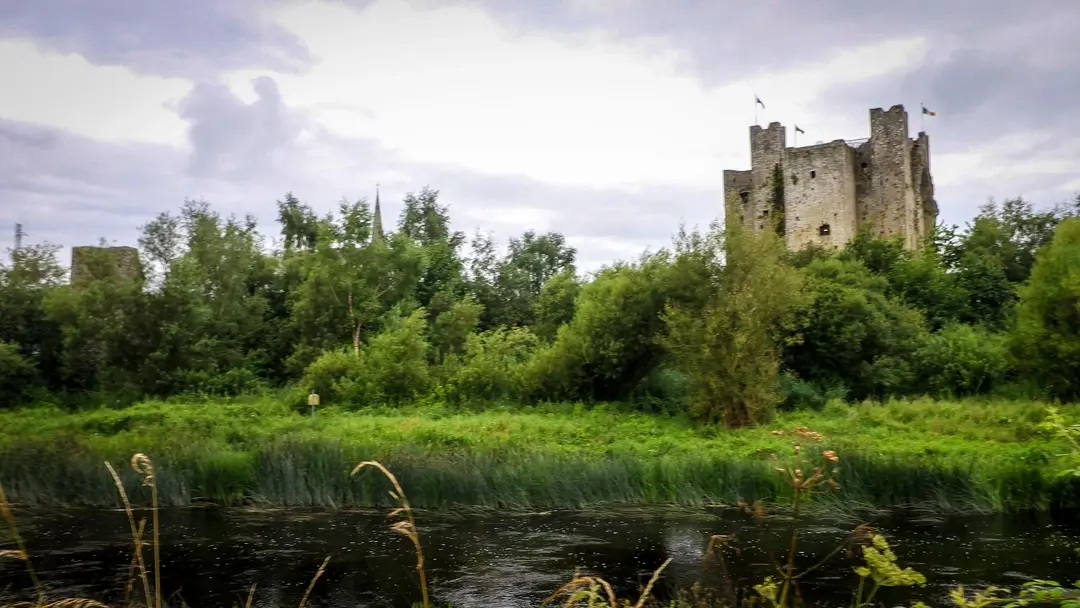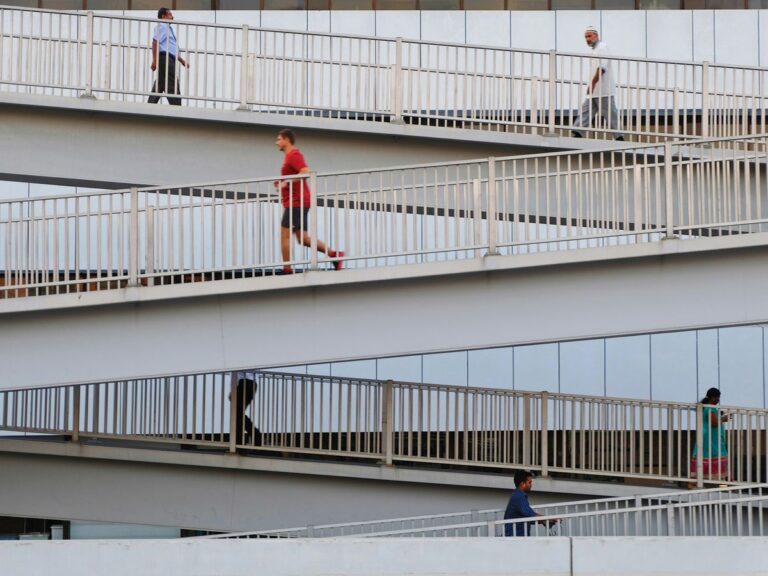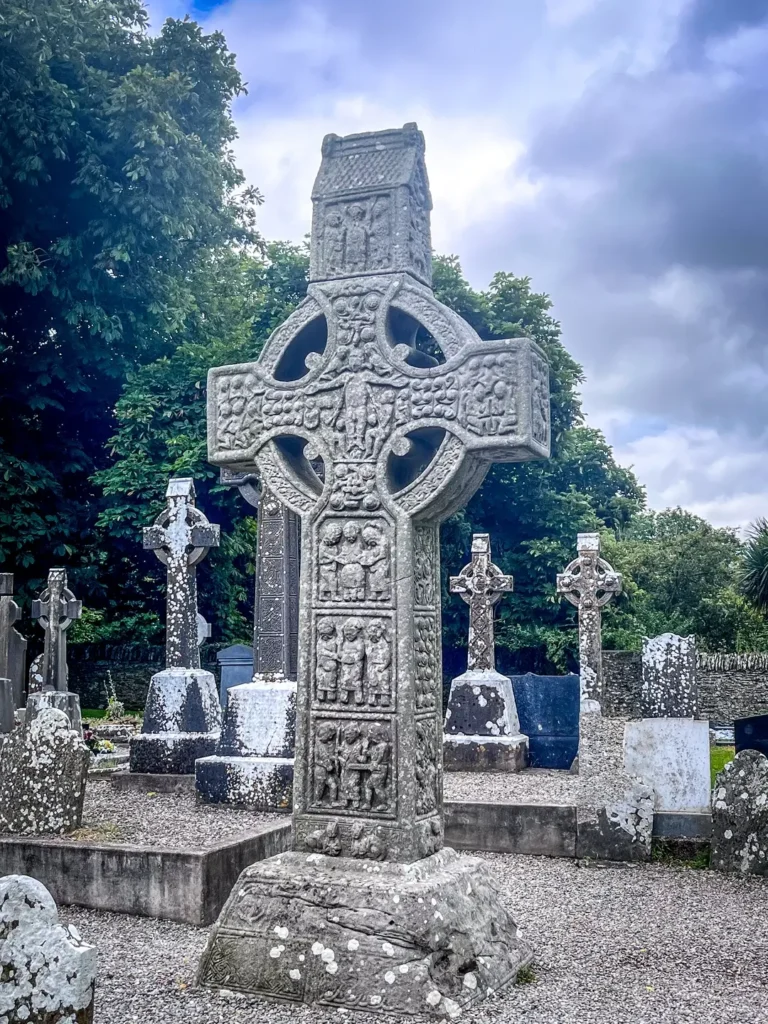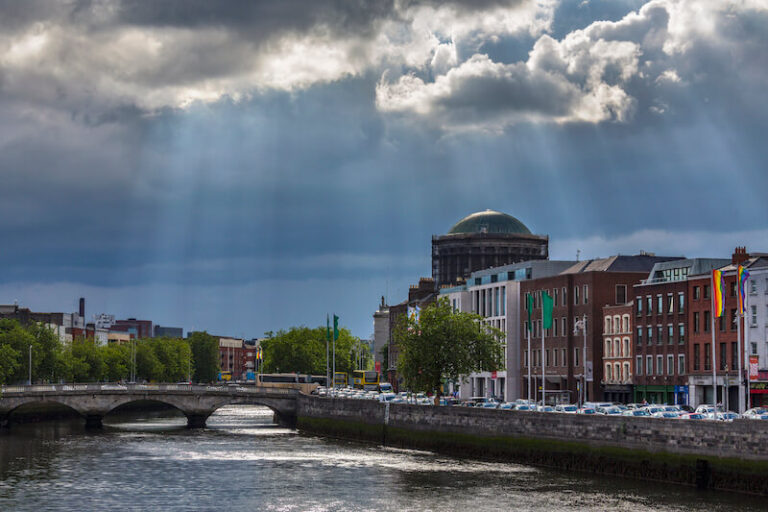Trim Castle’s Military Role
Trim Castle, located in County Meath, Ireland, stands as a powerful reminder of medieval military might. Built over centuries, this huge stone fortress wasn’t just a fancy building; it was a key player in many historical events. From its clever design to its part in big battles, the castle’s story is all about its military importance. Let’s dig into how Trim Castle became such a vital stronghold and what made it so tough to beat.
Key Takeaways
- Trim Castle was built in a smart spot overlooking the River Boyne, giving it a good view and control over important routes.
- The castle had some cool, new design ideas for its time, like its unique cruciform keep and strong walls, making it really hard to attack.
- It was a big symbol of Norman power in Ireland, showing everyone they were there to stay and meant business.
- Trim Castle saw a lot of action, holding strong during sieges and conflicts, proving its worth as a defensive site.
- Over time, its military role faded, but the castle still stands as an important piece of history, even appearing in movies like “Braveheart.”
Strategic Location and Early Construction
Initial Timber Fortification
So, Trim Castle. It didn’t just pop up overnight as this massive stone thing. The story actually starts a bit earlier, with a timber castle. After Hugh de Lacy got the go-ahead to control the area, building something quick was the first order of business. Think of it as a temporary solution, a ‘we’re here to stay’ sign hammered into the ground. Of course, being made of wood, it wasn’t exactly invincible. It got wrecked pretty fast in an attack. But hey, it was a start, right?
Commanding View of the River Boyne
Location, location, location! That’s what they say, and Trim Castle definitely nailed it. It sits up high, giving you a killer view of the River Boyne. Back then, that river was like a highway. It was super important for moving stuff around, both for trade and for, you know, armies. Being able to see who’s coming and going was a huge advantage. It’s not just a pretty view; it’s a strategic one. The castle’s position allowed control of a vital route into Ireland’s interior.
Proximity to the Irish Sea
Okay, so the castle isn’t exactly on the Irish Sea, but it’s close enough to matter. The River Boyne is navigable, meaning boats could sail a good distance inland. That connection to the sea meant easy access to trade routes and reinforcements from across the water. It made Trim a key spot for the Normans to control. Think of it as having a direct line to the outside world, which was pretty important when you’re trying to establish yourself in a new place.
The strategic placement of Trim Castle wasn’t accidental. It was a calculated move to dominate the region, control vital waterways, and project Norman power deep into Ireland. The initial timber structure, though short-lived, paved the way for the imposing stone fortress that would become a lasting symbol of their presence.
Architectural Innovations and Defensive Features
The Unique Cruciform Keep
Okay, so the main thing about Trim Castle is its keep. It’s not your average square or round tower; it’s cruciform, meaning it’s shaped like a cross. This was a pretty big deal back in the day. The design gave defenders more angles to shoot from, making it harder for attackers to get close. Plus, the thick walls – we’re talking nine feet in some places – made it super tough to breach. It was a statement, you know? Like, ‘We’re here, and we’re not going anywhere.’
Expansive Curtain Walls and Towers
Beyond the keep, the castle had these massive curtain walls surrounding the whole thing. Think of them as a protective shell. And dotted along these walls were towers, each serving as a lookout point and a defensive position. These walls and towers gave the castle its scale and made it a formidable obstacle for anyone trying to get in. The castle structures were designed to withstand long sieges, and they did, for centuries.
Protective Ditch and Moat
To add another layer of defense, they dug a ditch and created a moat around parts of the castle. This made it even harder for attackers to reach the walls. Imagine trying to lug siege equipment across a water-filled ditch while getting shot at – not fun. The River Boyne was a key part of the luxury chauffeur services defense strategy, providing a natural barrier on one side. It’s all about making it as difficult as possible for the enemy.
The ditch and moat weren’t just about keeping people out; they also controlled access. Anyone wanting to enter had to go through specific points, making them vulnerable. It was a clever way to manage who came in and out, adding another layer of security to the whole setup.
Here’s a quick breakdown of some key defensive features:
- Thick walls to resist attacks
- Strategic tower placement for maximum visibility
- Moat and ditch to slow down attackers
- Gatehouses to control entry points
Symbol of Norman Authority
Trim Castle wasn’t just a pile of rocks; it was a statement. It shouted, “The Normans are here, and they’re in charge!” The sheer size and design of the castle were meant to impress and intimidate, showing everyone who was now calling the shots. It’s easy to see why it became such a potent symbol.
Statement of Power and Permanence
The castle’s imposing structure was a clear message: Norman rule was here to stay. It wasn’t some temporary camp; it was a solid, stone declaration of dominance. The massive keep, the high curtain walls, everything about it screamed power. It was designed to last, projecting an image of unshakeable authority. It’s like they were saying, “We’re not going anywhere.”
Anglo-Norman Presence in Ireland
Trim Castle became a central point for the Anglo-Normans in Ireland. It was more than just a military base; it was a hub for their culture, administration, and way of life. The castle helped solidify their presence and influence in the region. It served as a base from which they could control the surrounding lands and enforce their laws. It was a physical representation of their claim to the territory. You can learn more about the castle’s opening hours before visiting.

Engineering Prowess
The construction of Trim Castle was a feat of engineering for its time. The Normans brought new building techniques and designs to Ireland, and the castle showcased their skills. The cruciform keep, with its thick walls and strategic layout, was a testament to their knowledge and innovation. It wasn’t just about building something big; it was about building something strong, defensible, and impressive. It showed they had the know-how to dominate the landscape, and it was a clear sign of their engineering prowess.
The castle’s design wasn’t just about defense; it was about making a statement. The Normans wanted to show off their skills and impress the locals. They succeeded in creating a structure that was both functional and symbolic, a lasting reminder of their power and influence.
Here are some key features that highlight the engineering achievements:
- The cruciform keep design, unique for its time.
- The use of advanced stone masonry techniques.
- The complex system of walls, towers, and ditches for defense.
Trim Castle’s Role in Medieval Conflicts
Defense During the Bruce Campaign
Trim Castle faced a significant test during the Bruce Campaign in the early 14th century. Edward Bruce, brother of Robert the Bruce of Scotland, invaded Ireland, aiming to open a second front against the English. Trim Castle, as a key Anglo-Norman stronghold, became a target. The castle’s strong defenses were crucial in withstanding the challenges posed by Bruce’s forces, helping to limit their advance into the region. The castle’s strategic importance was clear during this period, as it served as a vital point of resistance against the Scottish invasion.
Withstanding Sieges and Attacks
Throughout its history, Trim Castle was subjected to several sieges and attacks. Its robust design, featuring thick curtain walls and a formidable keep, proved effective in repelling invaders. The castle’s location along the River Boyne also provided a natural defensive advantage. While specific details of every siege might be scarce, the fact that the castle remained a significant power center demonstrates its success in withstanding these challenges. The three-story keep, with its unique cruciform shape, was a major factor in the castle’s resilience.
Contested Site in Irish Affairs
Trim Castle’s importance extended beyond simple military defense; it became a focal point in the broader context of Irish affairs. Control of the castle shifted hands at times, reflecting the changing power dynamics between the Anglo-Normans and the native Irish. It served as a seat of power during the Norman conquest and later became a contested site during the Irish Confederate Wars in the 17th century. The castle’s history is intertwined with the larger narrative of conflict and control in medieval Ireland.
Trim Castle wasn’t just a pile of stones; it was a symbol. It represented Norman power, and whoever held it had a significant advantage in controlling the surrounding area. This made it a constant target and a key piece in the ongoing struggle for dominance in Ireland.
Here’s a simplified timeline of some key conflicts:
- Early Norman Period: Key stronghold for Anglo-Norman expansion.
- Bruce Campaign: Served as a defensive point against invasion.
- Later Medieval Period: Site of ongoing skirmishes and power struggles.
Evolution and Decline of Military Importance
Loss of Strategic Relevance
Okay, so picture this: for centuries, Trim Castle was the place to be if you wanted to control the area. But, like, things change, right? By the 16th century, the castle started to lose its edge. The way wars were fought was evolving, and castles, in general, weren’t as important as they used to be. New technologies and strategies meant that the old stone walls just weren’t cutting it anymore. It’s kind of like how your old phone becomes obsolete when the new model comes out. The castle’s strategic importance waned as Ireland’s political and military landscape shifted.
Partial Dismantling and Disuse
So, what happens when something loses its purpose? Well, it often gets neglected. Trim Castle was no exception. Over time, parts of it were actually dismantled. I mean, why keep up a huge, expensive fortress if you don’t really need it? It fell into disuse, becoming more of a historical relic than a functioning military site. It’s a bit sad, but also kind of fascinating to see how things change over time. It’s like finding an old, abandoned factory – you can see the history, but it’s no longer serving its original purpose.
Enduring Historical Significance
Even though Trim Castle wasn’t a military powerhouse anymore, it didn’t just disappear into the mists of time. It remained a powerful reminder of Ireland’s storied past. It still stood as a symbol of Norman power and a testament to the castle’s role in Irish history. People recognized its historical and architectural importance, which is why there were many attempts to preserve and restore it during the 20th century. It’s like that old family photo album – it might not be useful in a practical sense, but it’s full of stories and memories that are worth preserving.
Think of it this way: Trim Castle went from being a key player in medieval conflicts to a historical landmark. Its military days were over, but its story was far from finished. It became a place for people to connect with the past and learn about the events that shaped Ireland.
Beyond Military Function
Trim Castle wasn’t just about battles and defense. It played other important roles in the area, impacting daily life for many people.
Administrative Hub for the Region
Trim Castle served as a central point for managing the surrounding lands. Think of it as the local government headquarters. Decisions were made here, and orders were sent out. It was where the Anglo-Norman rulers exerted their control, managing resources and settling disputes. The castle was the place to go for official business, solidifying the Norman influence in the region.
Center of Economic Activity
Markets and fairs sprung up around the castle walls. People came to trade goods, sell their crafts, and buy what they needed. This created a bustling atmosphere and made Trim a vital economic hub. The castle provided security, which encouraged commerce. It was a win-win situation for everyone involved.
Here’s a simple look at the economic impact:
| Activity | Description |
|---|---|
| Market Days | Weekly events attracting traders and buyers |
| Craft Fairs | Showcasing local artisans and their work |
| Trade Routes | Passing through Trim, boosting local economy |
Home for Families Over Centuries
It’s easy to forget that castles weren’t just fortresses; they were also homes. Families lived within those walls for generations. Children were born and raised there. Servants worked in the kitchens and halls. The castle was a community, with its own unique culture and traditions.
Imagine the daily life within the castle walls. The sounds of children playing, the smells of cooking, and the constant activity of a busy household. It wasn’t always glamorous, but it was home.
Here are some aspects of family life within the castle:
- Daily meals and routines
- Education for children of noble families
- Celebrations and social gatherings
Cultural Impact and Modern Recognition
Filming Location for Braveheart
Trim Castle gained a lot of attention after being featured in the movie Braveheart. The castle’s imposing structure and medieval look made it a perfect backdrop for the film’s battle scenes. It’s interesting how a movie can bring so much attention to a historical site. People come from all over to see where parts of the movie were filmed. It really shows how movies can shape our view of history and places.
Cinematic Experience and Tourism
Visiting Trim Castle after seeing Braveheart is a unique experience. The castle’s towering walls and historic charm create a cinematic feel, transporting you back to the medieval times. It’s not just about seeing a castle; it’s about reliving a movie. The impact of the film on tourism is undeniable. People want to walk where Mel Gibson walked, even if it’s just a historical landmark now.
Symbol of Ireland’s Medieval Heritage
Trim Castle stands as a powerful symbol of Ireland’s medieval past. It represents the Norman influence, the battles fought, and the passage of time. It’s more than just a pile of stones; it’s a reminder of the events that shaped the country. The castle’s enduring presence connects modern Ireland with its complex history. It’s a place where you can almost feel the echoes of the past. It’s a cultural treasure for future generations.
Trim Castle is a testament to Ireland’s complex history. It bridges the gap between the Norman conquest and modern Irish identity, offering visitors a glimpse into the medieval world.
Here’s a quick look at how Trim Castle contributes to the community:
- Local events, like medieval fairs, keep the castle a vibrant part of community life.
- Ongoing conservation efforts protect the site for future generations.
- Schools often include Trim Castle in their history programs, allowing students to engage with Ireland’s past in a tangible way.
The way this topic has shaped our world and how people see it today is pretty amazing. To learn more about its lasting effects and how it’s celebrated now, check out our full article on our site. You won’t want to miss it!
Conclusion
So, when you look at Trim Castle, it’s pretty clear it was built for serious business. It wasn’t just some fancy house; it was a military base, plain and simple. From its super strong walls to its smart location, everything about it screamed defense. It really shows how important these kinds of places were back then for keeping control and staying safe. Even now, you can still feel that history when you walk around the grounds. It’s a real reminder of a time when castles like this were at the center of everything, protecting people and power.
Frequently Asked Questions
Who built Trim Castle and why?
Trim Castle was built by Hugh de Lacy, an Anglo-Norman lord. He started building it shortly after he arrived in Ireland. It was meant to be a strong military base and a center for managing the area, helping the Normans control the land around them.
What makes Trim Castle’s design special?
The castle is famous for its unique cruciform (cross-shaped) keep, also known as the Great Tower. This design was very unusual for its time and made the castle much stronger against attacks. It also had huge curtain walls, towers, and a moat, all designed to keep enemies out.
Why was Trim Castle’s location so important?
Trim Castle was very important because of its location. It sat on high ground overlooking the River Boyne, which was a key crossing point. This allowed the Normans to control trade and military movements between the Irish interior and the coast, making it a vital spot during medieval wars.
Did Trim Castle play a role in any major battles?
Yes, Trim Castle played a big part in many conflicts. It was a key stronghold during the Norman conquest and later became a battleground during the Irish Confederate Wars. It survived many sieges and attacks, showing how strong and important it was for defense.
Why did Trim Castle lose its military importance?
Over time, as fighting methods changed and the political situation in Ireland shifted, Trim Castle became less important as a military fort. It eventually fell into disuse and parts of it were taken apart. However, it remains a very important historical site today.
What famous movie was filmed at Trim Castle?
Trim Castle is famous for being a filming location for the movie “Braveheart.” It was used to represent the walled city of York in the film. This helped bring the castle to the attention of many people around the world and boosted tourism to the site.





